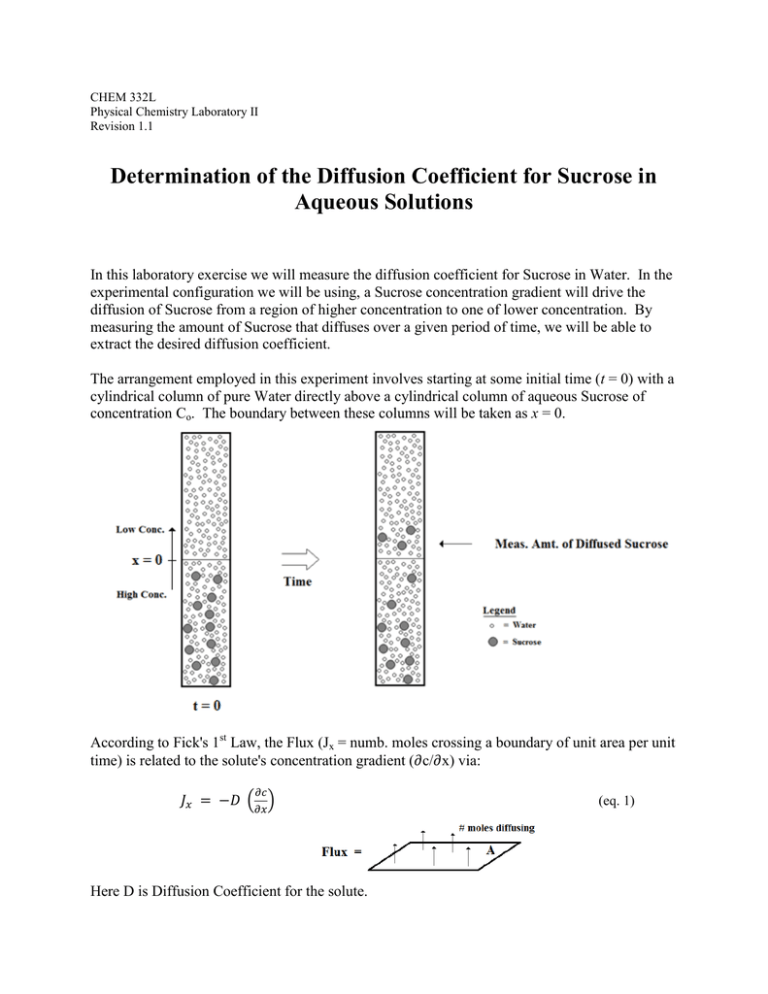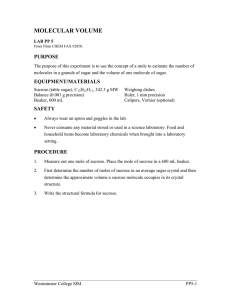Determination of the Diffusion Coefficient for Sucrose in Aqueous
advertisement

CHEM 332L Physical Chemistry Laboratory II Revision 1.1 Determination of the Diffusion Coefficient for Sucrose in Aqueous Solutions In this laboratory exercise we will measure the diffusion coefficient for Sucrose in Water. In the experimental configuration we will be using, a Sucrose concentration gradient will drive the diffusion of Sucrose from a region of higher concentration to one of lower concentration. By measuring the amount of Sucrose that diffuses over a given period of time, we will be able to extract the desired diffusion coefficient. The arrangement employed in this experiment involves starting at some initial time (t = 0) with a cylindrical column of pure Water directly above a cylindrical column of aqueous Sucrose of concentration Co. The boundary between these columns will be taken as x = 0. According to Fick's 1st Law, the Flux (Jx = numb. moles crossing a boundary of unit area per unit time) is related to the solute's concentration gradient ( c/ x) via: (eq. 1) Here D is Diffusion Coefficient for the solute. Page |2 Initially, of course, according to this experimental arrangement, the concentration gradient occurs at x = 0. Over time, however, this concentration gradient will begin to soften and fade. According to the Law of Conservation of Mass, the change in Flux along the x-axis is dependent on how the solute concentration changes with time: (Eq. 2) Differentiating Jx in Equation 1 with respect to x and assuming D is concentration independent (good only at dilute concentrations) yields Fick's 2nd Law, which describes how the concentration will change with time: (Eq. 3) Our experimental arrangement dictates the following boundary conditions for this partial differential equation: C = Co = 0 at t = 0 for x ≤ 0 for x > 0 C = Co = 0 at t > 0 for x = - ∞ for x = + ∞ It is assumed the cylinders are infinitely long; which is not a bad assumption if the diffusion time is relatively short. Solving Equation 3 using these boundary conditions yields: C = (Eq. 4) which in turn gives us the concentration gradient needed in Fick's 1st Law: (Eq. 5) At the initial boundary of x = 0, we then have a concentration gradient of: Page |3 (Eq. 6) We can now write Fick's 1st Law (Equation 1) as: Jx = (Eq. 7) But, by definition, Jx can be written as: Jx = (Eq. 8) where n is the number of moles of solute molecules diffusing. Equating these two expressions for the flux, separating variables and integrating yields: n = (Eq. 9) Now we recognize that after a period of diffusion, the solution in the upper cylinder, which we now take to have height h, will be collected and mixed. This will give us a concentration: C = (Eq. 10) Solving for n in Equation 10, inserting the result into Equation 9 and then solving for D gives us our desired result: D = (Eq. 11) This can be re-arranged according to: = (Eq. 12) A plot of (C/Co) vs. t1/2 should yield a straight line with a slope of: slope = (Eq. 13) from which we can extract the Diffusion Constant D. Thus, by starting with Sucrose at a concentration of Co in the lower cylinder, allowing it to diffuse for a period of time t and measuring the mixed concentration C in the upper cylinder we can determine the diffusion coefficient D for Sucrose in Water. Page |4 The question that now concerns us is how to determine the concentration of diffused Sucrose. One analytic method for the detection of Sucrose involves the reaction of Sucrose with Phenol under acidic conditions. Sucrose Phenol The protonated Sucrose (any of the alcohol functionalities of the Sucrose molecule can be protonated) dehydrates and then attacks the Phenol in an electrophilic aromatic substitution reaction. The product is yellow in color (see spectrum below; absorbance maximum occurs are 495 nm) and can be used in a colorimetric assay. VIS Spectrum of Product Absorbance 2 1.5 1 0.5 0 400 450 500 550 600 Wavelength [nm] So, we first form calibration standards of known Sucrose concentration and treat them with Phenol and Sulfuric Acid (H2SO4) to produce the colored product whose absorbance can be measured. This calibration data can then be used to determine the unknown Sucrose concentrations from the diffusion experiment. Page |5 Procedure Calibration Data Safety: Phenol and Conc. Sulfuric Acid are extremely caustic. Phenol can be absorbed through the skin. You must wear safety goggles, gloves and a plastic apron when working with these substances. General Caution: If you use Acetone to dry any of your glassware, make sure it has completely evaporated. Acetone in any of the mixtures will interfere with the colorimetric assay. 1. Turn on and warm up the UV-VIS spectrometer. Set it to take single wavelength absorbance measurements at 495 nm, the absorbance maximum for our colored product. 2. Prepare 100 mL of a 5% aqueous Phenol solution. (Work in the fume hood when making this preparation.) Obtain ~100 mL of concentrated Sulfuric Acid. 3. Prepare 100 mL of a 1% aqueous Sucrose stock solution. Then prepare the following dilutions of this stock solution: 1 mL to 500 mL 2 mL to 250 mL 1 mL to 100 mL 4 mL to 250 mL 4. For each of these calibration standards, pipette 1 mL of the Sucrose and 1 mL of the Phenol solutions into a 25 mL Erlenmeyer flask. Mix the resulting solution well. Then, to each, add, using a 5 mL pipette, the conc. Sulfuric Acid. Delivery of the acid should be to the surface of the Sucrose-Phenol mixture to promote heating. Be very cautious when pipetting the conc. acid; it is a very viscous substance. Do not let it drip all over the counter top. Also, because considerable heat will be produced, hold the flask near its neck. Finally, perform this step in the fume hood. Mix each solution thoroughly. 5. A "blank" solution can be prepared by pipetting 1 mL of Water and 1 mL of the Phenol solution together and adding via a pipette 5 mL of conc. Sulfuric Acid. 6. After each solution has cooled, measure its absorbance. 7. Use your data to prepare a calibration curve for your standard Sucrose solutions. Add an appropriate trend-line to your chart. Diffusion Data All of our diffusion measurements will be carried out using a Polson Cell; pictured below. Page |6 This Cell is designed to allow a cylindrical column of solvent to be quiescently rotated into position over a cylindrical column of solution. When the two cylinders are empty and rotated into position over each other, the lower sample cylinder can be filled to just above the "boundary." The upper sample cylinder can then be rotated out of place and a neighboring upper sample cylinder can be filled. This can then be rotated over the filled lower sample cylinder for the desired diffusion time. The upper chamber can then be rotated out of place and the sample withdrawn for analysis. The Polson Cell is constructed with 6 cylinders that are 0.25" in diameter and 3 cm in height. 1. Obtain a Polson Cell and very, very lightly grease the interface between the upper chambers and the lower chambers. This will allow for a Water tight seal between the two parts of the Cell. When using the Cell minimize handling it as it is not jacketed with a temperature bath and we are taking the Cell temperature as Room Temperature. 2. Note the Room Temperature. Page |7 3. Prepare 100 mL the following aqueous Sucrose solutions in a volumetric flask: 0.6g Sucrose / 100 mL Sol'n 1.0g Sucrose / 100 mL Sol'n 2.0g Sucrose / 100 mL Sol'n 4. Using the rotation scheme diagramed above, fill, using a Pasteur Pipette, every other lower chamber with a Sucrose solution of the same concentration. Then fill every other upper chamber with Water. 5. Start a stopwatch when you rotate the upper chamber so that it is directly over the lower chamber. Allow diffusion to occur for about 3 minutes. Stop the stopwatch when you rotate the upper chamber out of place so that diffusion ends. 6. Withdraw, using a Pasteur Pipette, the liquid from each of the three filled upper chambers. Combine them together in a single 25 mL Erlenmeyer Flask. Label the flask. 7. Repeat this procedure using the same Sucrose solution for diffusion times of 5 and 7 minutes. 8. Repeat the three diffusion measurements for each of the remaining Sucrose solutions. 9. Analyze each of your diffusion samples using the same procedure as outlined above. 10. Rinse, clean and store your Polson Cell. Page |8 Data Analysis All results must be accompanied by an appropriate error estimate. 1. Use your calibration data to prepare a calibration curve. You should use Excel or some other software package to prepare this curve. Add a linear-least-squares trendline to your curve. You should force the curve to go through the (0,0) as you will have a zero absorbance when no sample is present. 2. Convert your diffusion sample absorbance measurements to Sucrose concentrations using the above calibration curve. 3. For each initial Sucrose concentration, plot (C/Co) vs. t1/2 and perform a linear-least-squares analysis such that the line is forced through the (0,0). Now determine the diffusion constant D. 4. If D is found to be sensitive to Sucrose concentration, plot D vs. Co and extrapolate to Co = 0 in order to obtain Do; the zero concentration diffusion constant. Otherwise simply average your results to obtain Dav. 5. Compare your result with appropriate literature values. Page |9 References Castellan,Gilber W. (1983). "Physical Chemistry," 3rd Ed. Addison-Wesley. Edward, John T. "Molecular Volumes and the Stokes-Einstein Equation." J. Chem. Ed. 47 261 (1970). Halpern, Arthur M. and Reeves, James H. (1988) "Experimental Physical Chemistry: A Laboratory Textbook." Scott, Foresman and Company, Glenview, Illinois. Linder, Peter W., Nassimbeni, Luigi R., Polson, Alfred and Rodgers, Allen L. "The Diffusion Coefficient of Sucrose in Water." J. Chem. Ed. 53 331 (1976).


